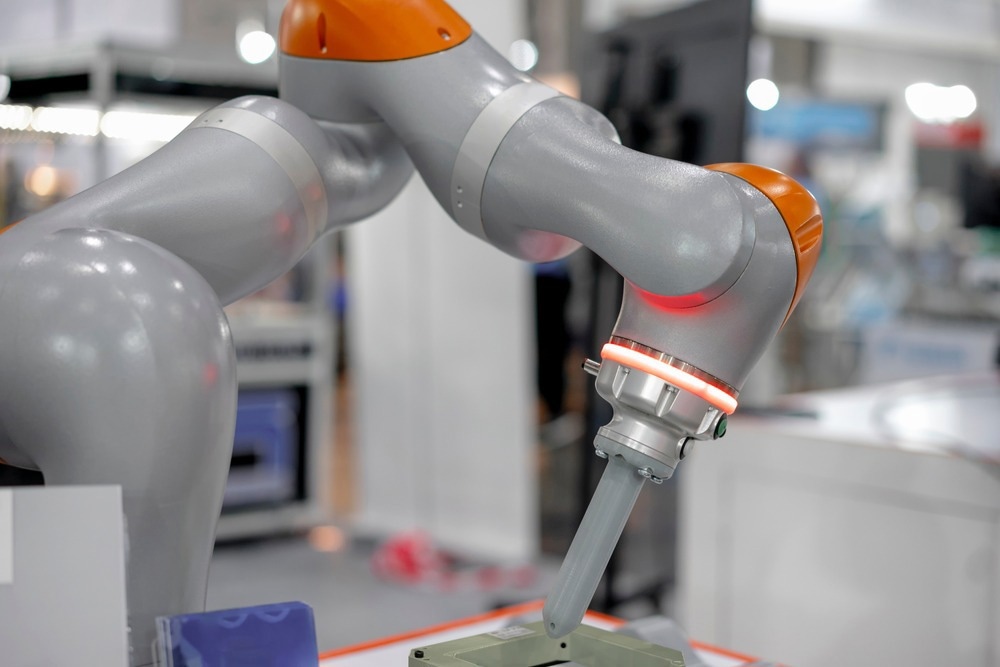Robots are used for a wide range of applications, such as mobilizing biological and chemical samples, synthesizing novel chemical compounds, and testing the pharmaceutical value of compounds. Most importantly, robotics has been widely adopted to facilitate automation in the lab.
Before laboratory robotics, trained technicians were required to carry out processes manually; this was resource intensive and subject to human error. Automation with robotics rapidly caught on as a way to speed up this process, increase accuracy, reduce overheads, and free up skilled staff members for more complex tasks.
In addition to adopting automation, laboratory robotics have become popular because they enhance the standardization of laboratory processes. Standardization is vital to scientific tests, as without it, results produced from tests would not be reliable, and industry uniformity would not be achievable.

Image Credit: August Phunitiphat/Shutterstock.com
What Are Cobots?
Now, the industry is moving towards incorporating cobots into their processes in addition to robots. The term cobots is shorthand for ‘collaborative robots’. This technology has emerged to work alongside humans rather than operate autonomously, like traditional robots. Cobots are designed to physically interact with and assist humans rather than complete entire tasks alone.
While the term cobot is not well-known, it is not actually new. The first examples of cobots date back to the mid-1990s, around a decade after the use of robots took off in laboratories. General Motors (GM) is one of the first companies documented to have adopted cobots into their processes. University research teams also began to make use of this technology at this time.
A cobot can be programmed to perform a wide range of tasks. Often, they are employed to conduct parts of a task that require strength, repetition, precision, or handling of dangerous substances. This technology is invaluable to improving the workflow of laboratories, where processes often rely on repetitive tasks that must be carried out precisely and often involve handling risky substances.
Why Are Cobots Beneficial to Lab Workflow?
The list of tasks that cobots can be programmed to carry out is not exhaustive. Depending on the goal, cobots can be developed to perform almost anything (within reason). They bring several advantages to laboratories that choose to adopt them.
For example, cobots are easy to program; they generally do not require extensive training for employees. Additionally, they offer enhanced efficiency compared with human workers carrying out the same task. This is because they do not tire like human employees, something that is a particular issue when the task is monotonous, and they are not vulnerable to human error.
Cobots also offer the opportunity to increase the return on investment (ROI) due to increasing error rates and increasing speed. While traditional robots are generally programmed to be able to perform a single task, cobots offer flexibility in that they can be programmed to perform various tasks.
Cobots are also making the lab a safer place for human workers by automating dangerous tasks and removing human workers from directly handling dangerous compounds. Finally, in the laboratory setting, cobots, like robots, have the benefit of reducing the risk of contamination.

Image Credit: Gorodenkoff/Shutterstock.com
Countries Utilizing Cobots
Currently, Europe represents the largest market for cobots, sharing 30% of the global market revenue for cobots in 2021. One of the most prominent examples of cobot use in this region is NiCoLA-B, the world’s most advanced drug discovery robot, created by AstraZeneca. The technology is currently being put to use in a joint drug discovery project with Cancer Research UK (CRUK).
Over the next decade, Asia Pacific will also rapidly adopt this technology due to the increasing emphasis in this region on implementing high standards.
As yet, cobots have not become commonplace in all global regions; however, this will likely change in the coming years. Possibly the biggest factor that is acting as a barrier to adoption is that cobots are generally slower than robots, which may encourage companies to choose robots over cobots.
Future Outlook for Cobots
To date, there are numerous cobots available on the market. Examples include GoFa and YuMi (ABB), Sawyer (Rethink Robotics), UR10 (Universal Robots), CR series (Fanuc Corporation) and more.
Cobots have a bright future. They are yet to be adopted in all regions with the same enthusiasm that has been seen in Europe; however, over the coming decade, this will likely change. As laboratories look to increase their productivity and reduce costs, cobots will become more widely adopted. Additionally, as big companies like AstraZeneca make the headlines with their successful use of cobots, it is likely to encourage other companies to follow suit.
References and Further Reading
AstraZeneca shares world-leading world’s most advanced drug discovery robot through Open Innovation [online]. Drug Discovery Today. Available at: http://www.drugdiscoverytoday.com/view/45282/astrazeneca-shares-world-leading-world-s-most-advanced-drug-discovery-robot-through-open-innovation/
Collaborative Robots in the Laboratory [online]. Automate. Available at: https://www.automate.org/blogs/collaborative-robots-in-the-laboratory
Collaborative Robots Market Size, Share & Trends Analysis Report By Payload Capacity, By Application (Assembly, Handling, Packaging, Quality Testing), By Vertical, By Region, And Segment Forecasts, 2022 - 2030 [online]. Grand View Research. Available at: https://www.grandviewresearch.com/industry-analysis/collaborative-robots-market
Kathleen Walch. 2019 You’ve Heard Of Robots; What Are Cobots [online]. Forbes. Available at: https://www.forbes.com/sites/cognitiveworld/2019/12/15/youve-heard-of-robots-what-are-cobots/?sh=4ce863284862
Transforming AstraZeneca's R&D productivity [online]. AstraZeneca. Available at: https://www.astrazeneca.com/what-science-can-do/topics/disease-understanding/transforming-astrazenecas-rd-productivity.html
Disclaimer: The views expressed here are those of the author expressed in their private capacity and do not necessarily represent the views of AZoM.com Limited T/A AZoNetwork the owner and operator of this website. This disclaimer forms part of the Terms and conditions of use of this website.